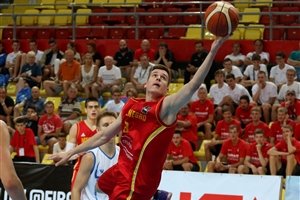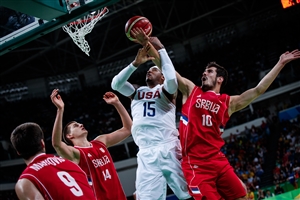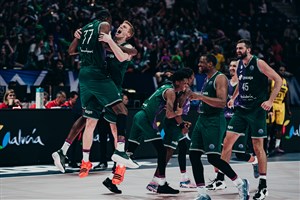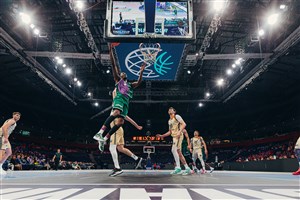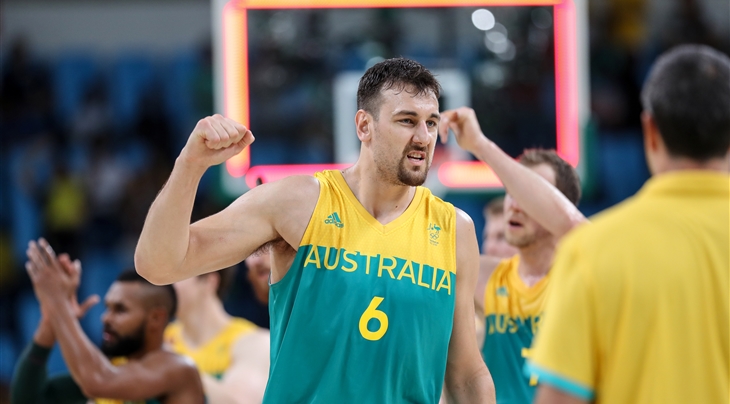
Rio notebook
MELBOURNE (Paulo Kennedy’s View from Downunder) - It's been a great week for Australian basketball, with a combined 7-1 record between the Opals and Boomers, but arguably the biggest heroes of that tale have barely been mentioned.
For those living on a different planet, on June 15 Andrew Bogut suffered a 6-8 week knee injury in the NBA Finals which put his Rio Olympic campaign in serious doubt.
Most supporters of Australian basketball just hoped he could give some minutes, even if they were limited and even if they were late in the tournament. Any Bogut is better than no Bogut as far as the Boomers are concerned.
But 46 days later, not only was he back, he was jumping out of his skin en route to 18 points at 90 per cent, five assists and four rebounds in 23 high-energy minutes as Australia routed France. Turns out the Bogut shake-and-bake we hadn’t seen since the Beijing Olympics is alive and well.
Unsung heroes
So who are these heroes I speak of? The Australian team's medical and conditioning staff, whose work with the ultra-committed Bogey man not only helped him get back on court in Rio but has seen him return as one of the tournament’s most influential players.
The stats tell a pretty good story, Bogut ranking first in two-point field goals at 82 per cent, second in blocks at 2.3 per game and ninth in assists at 4.7 per game, all in under 25 minutes per night. Without Bogut, Australia can be competitive with good teams, with him they have beaten the runners-up and third-place teams from the 2014 FIBA Basketball World Cup by double figures and taken the two-time World and Olympic defending champions down to the wire.
What the stats don't tell is how crucial Bogut's intelligence is to the Australian offence, with his ability to set bone-jarring screens, pick passing angles and recognise when his man is helping elsewhere and get to the front of the cup to finish.
The sort of ball movement and player movement that has made the Boomers almost impossible to guard and a pleasure to watch probably wouldn’t be possible without Bogut's smarts. He is to this Aussie team what Pero Cameron was to New Zealand in his prime, and that makes them tough to beat for anybody.
Kiwi heroes
Speaking of Cameron, three other heroes of this Boomers tale are his former Tall Blacks compatriots Tab Baldwin, Nenad Vucinic and Kirk Penney.
The tale goes that when Penney first signed with the New Zealand Breakers in the NBL, coach Andrej Lemanis was running him through his offensive sets when Kirk said something like, "Let's use Tab's stuff instead, it works".
'Tab's stuff', of course, was the offensive system that propelled New Zealand to the medal rounds of the 2002 FIBA Basketball World Cup, and has helped keep the Kiwis in the world's top 16 at World Cups ever since, with Nenad Vucinic adding his own wizardry to what is widely recognised as one of the planet's best offences.
Whether that story is true or not, sure enough that season the Breakers were running a variation of the NZ national team system, which became the offensive basis for a club now recognised as a powerhouse.
Lemanis class
That's not to take away from the work Lemanis has done. He moulded, added to and adjusted those offensive concepts to fit many different Breakers rosters, and has done likewise for this Boomers team.
Even with only one big who is a genuine perimeter threat, Lemanis has managed to open up the keyway for guards on backdoor cuts and hand-offs, and made it very difficult to cover shooters without opening up the basket for rolling big men, especially with Matthew Dellavedova in exquisite form.
The use of post players as screeners and passers away from the basket has made it incredibly difficult for defences to get in the passing lanes or clog the paint. It is a thing of beauty, one Kiwi fans have enjoyed for some time, and one Aussie supporters are now relishing.
How good has it been? In four games the Boomers have dished off 111 assists. In six games in 2014 that total was 102, in 2012 it was 106 in six games, while in 2010 it was just 78 in half a dozen outings.
In fact, since assists started being recorded at international tournaments, Australia have only surpassed 111 dimes three times, each in eight-game campaigns. The 1996 team holds the high mark with 147.
One US media report described Lemanis as "diligent" and I think that is the perfect word. He is a deep analyst of the sport who has studied the international game intensely and come up with a style that suits Australian players very well but is equally-suited to the international game.
Inconsistent Opals
The Aussie women haven't taken all before them as they did at the 2014 FIBA Women's World Championship. The element of surprise is well and truly gone and the hunters are now the hunted, but they are 4-0 with a combined winning margin of +47, clearly the second best differential in the tournament.
I think one factor being overlooked when it comes to the Opals' inconsistency is slotting Penny Taylor and Erin Phillips into the line-up at the last minute and figuring out how they best work with Liz Cambage, who they haven't played alongside in the green and gold since 2010.
With all the bigs complementary pieces in Turkey two years ago, substitutions could happen seamlessly and the style would change little. Put Cambage in the middle and the team's ability to play at pace in the open court or half-court is severely reduced, and that means significant adjustments.
Leilani Mitchell has looked very comfortable running the offence for Cambage, and while Taylor and Phillips team well with Liz too, they are both at their best when the ball is moving and they can take what the defence gives them, rather than playing a more structured game.
Match-making
The starting five of Cambage, Natalie Burton, Taylor, Phillips and Mitchell has been solid, +7 in their stints opening games and third quarters. The problem is in the lead-up matches they were dominant, reducing the pressure on the far less offensively-potent bench crew.
Cambage's foul trouble against France forced coach Brendan Joyce to play Marianna Tolo and Laura Hodges - the starting frontcourt group from Turkey 2014 - in tandem with Taylor for more minutes and it looked electric. Both Tolo and Hodges are very dangerous in dynamic ball-screen situations, and those moving passing targets make Taylor far more dangerous herself.
I would like to see more of Tolo-Hodges-Taylor-Katie Ebzery-Phillips playing together, moving the ball at pace ala the World Championship team of two years ago.
Then I'd prefer to see Cambage-Burton-Rachel Jarry-Mitchell and either of Taylor, Phillips or Tessa Lavey playing together more often with Cambage the undoubted focus. The Opals need to get the best out of Cambage, Taylor and Phillips to achieve their goals at this tournament, and who they take the court with matters.
Frontcourt combinations
Most of all it comes down to which bigs play together and to me a large part of that depends on the opposition. On opening night the Brazilian power forwards were too strong for Burton and Hodges, and Joyce wisely went to Tolo and Cayla George at the four-spot with great success.
The next game against Turkey, however, Joyce kept Hodges benched and used his bigs at power forward when Burton rested. They were exploited badly, the Turks shooting 47 per cent when either Tolo or George was at the four-spot compared to 35 per cent the rest of the game.
Against France, Joyce went with Burton and Hodges against the mobility of Endy Miyem and they delivered, keeping her without an offensive board after she had grabbed eight in the opening two games, and forcing her into 36 per cent shooting after she’d hit 61 per cent to open the tournament.
Against Japan it was a case of opposites. With Burton and Hodges slower than their opponents the Opals needed to go big, play zone defensively and exploit their size advantage offensively. It took Joyce more than three quarters to make this move - a bad coaching slip that can't afford to be repeated - but once he did the Aussies were +22 and shot 67 per cent with Tolo and Cambage on the court together.
The week ahead
The Boomers are flying and all-but wrapped up second place in Group A with their 93-68 win over China this morning. Their key now is to manage bodies without breaking the impressive rhythm they are in, because whether it's Argentina, Brazil, Croatia, Lithuania or Spain, there's a hell of a Quarter-Final coming their way.
I'm sure they would also like to get Ryan Broekhoff and Kevin Lisch into some rhythm. That pair are the consummate '3&D' wing duo, but were a combined 2-of-14 from long range after three games, something they need to improve to keep the defence honest.
The Opals have locked up top spot in Group A and have a chance to reduce the minutes of Cambage, Taylor and Phillips against Belarus, however they also need to use that game to figure out which combinations work best together and get some flow heading into what will be a tricky Quarter-Final.
Their defence of the high ball-screen and their ability to achieve dribble or pass penetration against zone defences are two keys they must get right before it’s elimination time.
Paul Kennedy
FIBA
FIBA's columnists write on a wide range of topics relating to basketball that are of interest to them. The opinions they express are their own and in no way reflect those of FIBA.
FIBA takes no responsibility and gives no guarantees, warranties or representations, implied or otherwise, for the content or accuracy of the content and opinion expressed in the above article.

